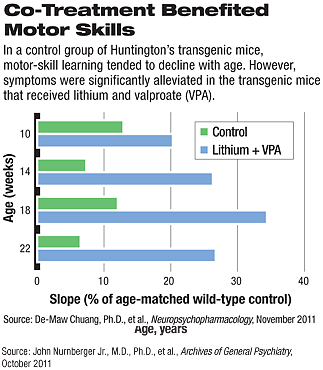Two mood stabilizers with a long history of safe use in humans—lithium and valproate—may hold important therapeutic potential for patients with the devastating and ultimately fatal neurode-generative disorder Huntington’s disease.
This message, based on results from two transgenic mouse models of Huntington’s, was reported in the November Neuropsychopharmacology and at the annual meeting of the American College of Neuropsychopharmacology in Hawaii in December.
The senior investigator was De-Maw Chuang, Ph.D., chief of the Section on Molecular Neurobiology at the National Institute of Mental Health.
Although lithium has been a standard treatment for bipolar disorder for more than half a century, and although valproate is also effective in treating bipolar disorder, the precise mechanisms of how these drugs work are still poorly understood. Yet emerging evidence suggests that both drugs promote cell proliferation and neurogenesis in the central nervous system. Thus both drugs might be capa ble of preventing neuronal cell death in Huntington’s, Chuang and his colleagues reasoned.
Another reason why they believed that this might be the case is that the two drugs promote cell proliferation and neurogenesis by inhibiting certain enzymes—glycogen synthase kinase 3 and histone deacetylases—and levels of these enzymes decrease in the brains of mouse models of Huntington’s around the time that behavioral deficits resulting from the disease become apparent.
Chuang and his group thus decided to see whether giving a combination of lithium and valproate in the diet to two widely used transgenic mouse models of Huntington’s disease could counter disease symptoms in the mice. Using multiple well-validated behavioral tests, they found that the combined drug treatment alleviated movement deficits, suppressed anxiety- and depressive-like behaviors, improved motor-skill learning and coordination, and prolonged average survival—from 32 weeks to 42 weeks.
The scientists also gave the two drugs separately to other Huntington’s mice and found similarly positive results, but not to the extent as when the two drugs were given together.
Two Key Proteins Increase
Analysis of brain tissue from the drug-treated mice demonstrated not only inhibition of glycogen synthase kinase 3 and histone deacetylases, but an increase in two proteins crucial for neuronal growth and protection—brain-derived neurotrophic factor and heat shock protein 70. These drug-induced brain changes contributed to the beneficial behavioral effects and prolonged survival observed in the mice that had received the drugs, the scientists suggested.
Thus, considering that “lithium and valproate are already Food and Drug Adminstration–approved medications with a long history of safe use in humans, and that the devastating symptoms of Huntington’s progressively intensify without remission until death, we believe that our data in these two distinct mouse models provide a strong rationale for using a combination of lithium and valproate to treat Huntington’s patients,” Chuang told Psychiatric News.
Human Trials Yet to Get Under Way
A protocol for studying the combined use of lithium and valproate in Huntington’s subjects was approved by the National Institutes of Health (NIH), Chuang pointed out, and he would have been a co-investigator. But the trial did not get off the ground because the principal investigator left NIH. In any event, in light of these new findings, “I very much hope that some clinicians will be interested in conducting a trial using both lithium and valproate for Huntington’s,” he said.
Meanwhile, findings from a few small, short clinical trials do suggest that lithium or valproate might benefit Huntington’s patients. For example, a 1973 trial found that lithium treatment strikingly reduced chorea and markedly improved voluntary movements in Huntington’s subjects. And a 2000 trial found that valproate helped relieve both movement disorders and psychosis in the subjects.
The research was funded by the Intramural Research Program of the National Institute of Mental Health.


